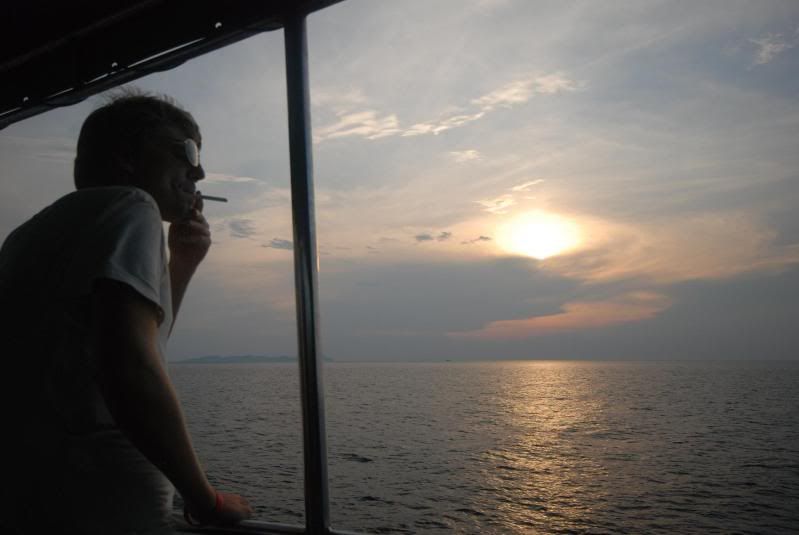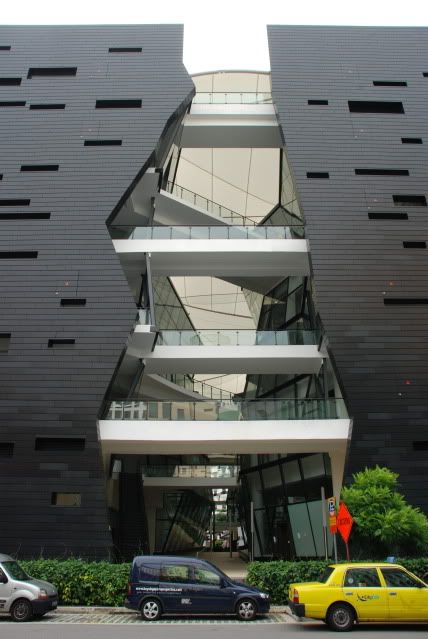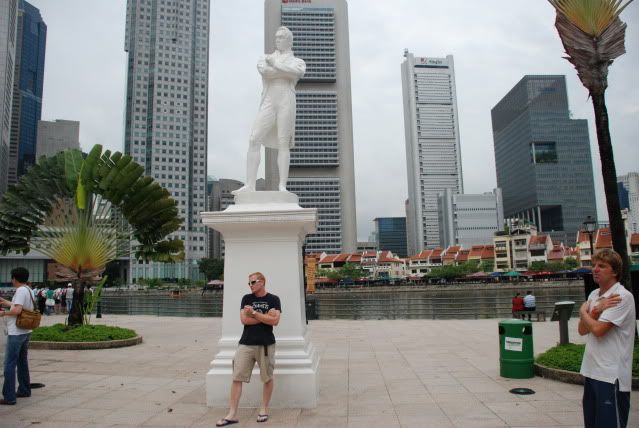Sumatra is just a short flight across the Strait of Melaka, but it is a whole world away. I read somewhere that new arrivals in Medan tend to experience one of two things - those coming from somewhere else in Indonesia think what a pleasant city it is, full of the joys of air-conditioning and middle class suburbs. Those arriving from elsewhere tend to think it is bedlam - which is exactly what I thought.
Culture shock doesn't come too easily to me, but I thought this might be a good place to explain a few of Indonesia's most obvious features to the uninitiated.
For those Indonesians with a little bit more English, you can now being a more in-depth conversation before working round to the reason they are talking to you. If it's a school-aged child, this reason is to ask you searching questions about your religion, government and opinion on Indonesia, before having a photo taken with all their friends on someone's camera phone. If the Indonesian is anywhere close to being an adult male, the reason is that, apart from being your new best friend, they can offer you some kind of service for just a nominal fee - usually expressed as "for you, I make very good price".
Once in Medan, I passed the queues of taxi drivers looking for becak to take me to a hotel - I had heard they were cheaper but, given that I hadn't really established what they looked like, ended up taking a taxi to a guesthouse. My taxi driver was a friendly fellow - within minutes I had his mobile number and he was suggesting I could do some business with him. He suggested a girl for a massage (with a "happy ending". no doubt") or the disco that evening; after I declined, he suggested maybe it was two girls I was after. We arrived at the guesthouse not a moment too soon, to find it levelled to the ground. I eventually made it to another hotel, despite my taxi-friend's objections that it was a "clean hotel" that didn't allow girls for massage.
I have yet to hear a positive word uttered about Medan. In the late '80's and early 90's, Sumatra was a major spot on the backpacking trail and tourist infrastructure existed. After the 1997 Asian financial crisis, the Bali bombs and the tsunami, Sumatra had almost been wiped off the map as a destination, replaced by Thailand, Laos, Cambodia and Vietnam. Medan is a prime example of why tourism is failing - or maybe it was like this because tourism was failing. There was a constant, mostly friendly hassle, but trying to acheive anything without being completely ripped off was a challenge. I stayed the night and the following morning headed up to Banda Aceh, at the northern tip of Sumatra.
Banda Aceh leapt to unwanted global fame after the Boxing Day tsunami in 2004. As the closest large city to the epicentre of the earthquake, many buildings were damaged before the tsunami hit. Arriving by air it was clear that there would have been little escape possible as the surrounding land is all flat. Notably the large mosque in Banda escaped almost unscathed, interpreted as a sign from God by the locals.
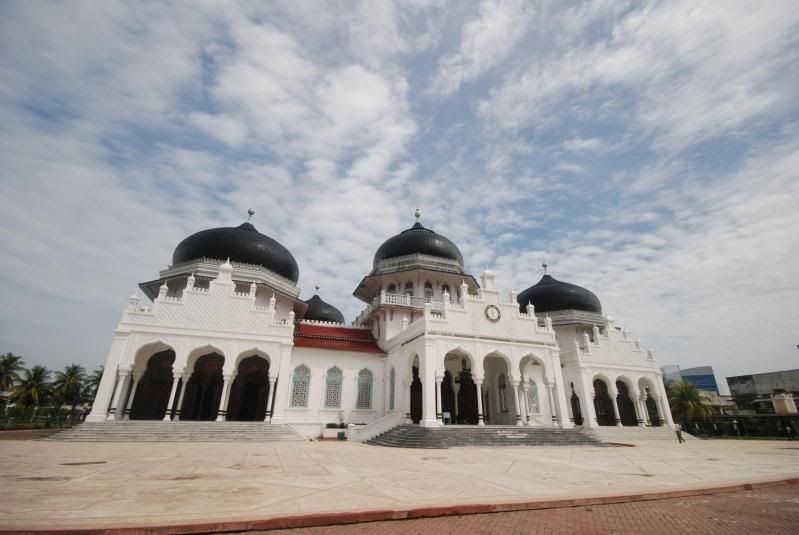
The province of Aceh, confusingly situated north of "Northern Sumatra", has also witnessed a separatist conflict lasting years, that ended only in 2006 with the signing of a deal to allow a large part of Aceh's export revenues to be kept within the province.
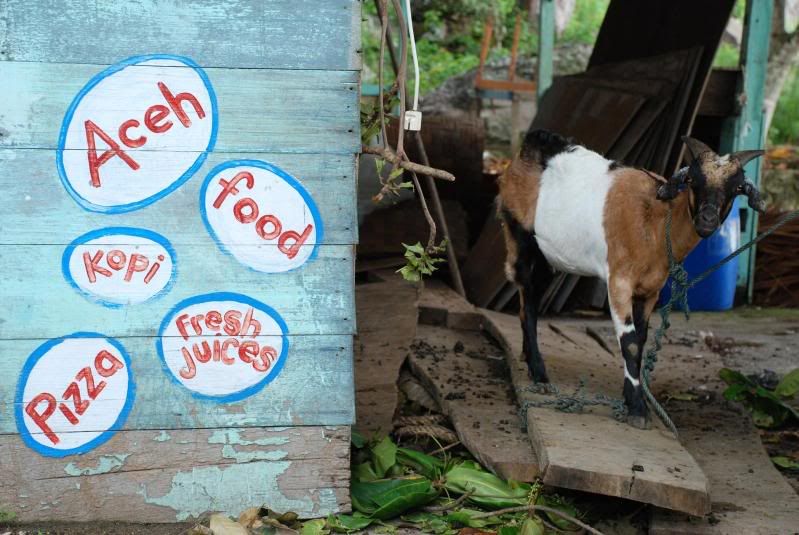
From the airport I hooked up with a couple of French travellers and headed directly to the brand-new port, past countless new concrete buildings and shiny blacked-put NGO vehicles. An express ferry for Pulau Weh, an island a few kilometres off the northern tip of Sumatra, soon after - my final destination was Iboih, a laid back village on a quiet bay with friendly locals and excellent diving.
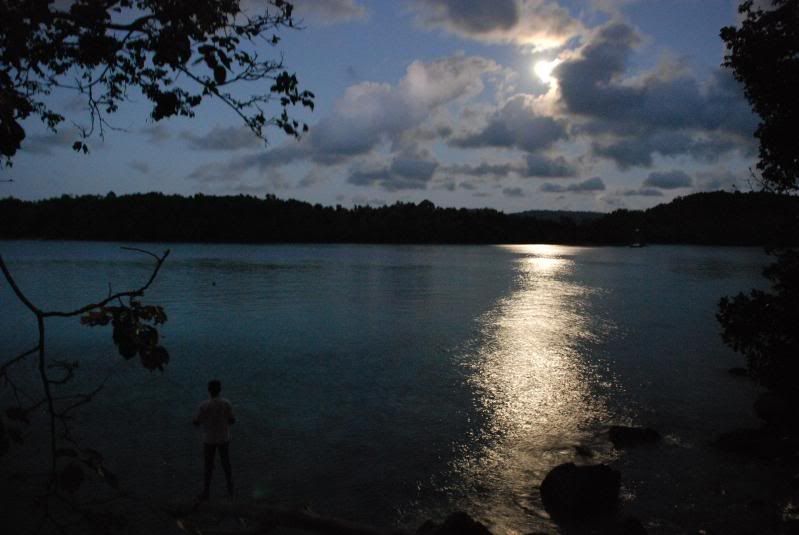
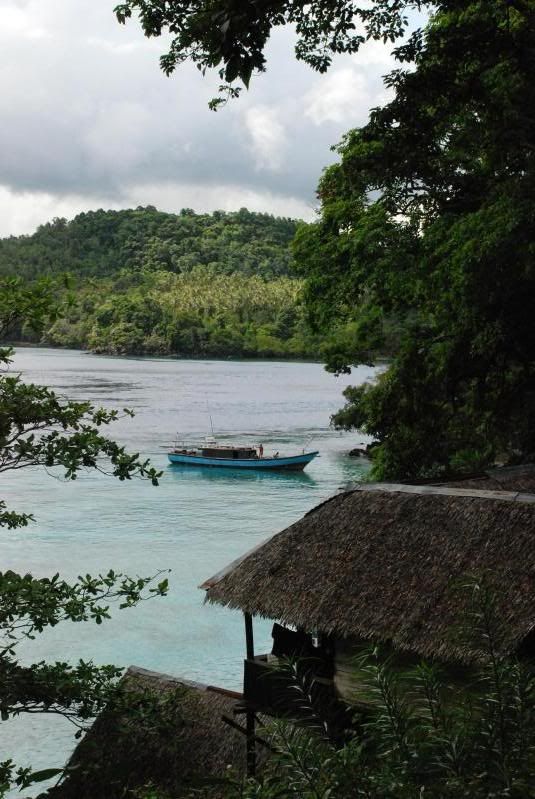
The next week passed quickly; it was bliss not to have to worry about the usual transport rip-offs or hassles from locals. I stayed in a run-down chalet with a shared saltwater mandi - that grew tiring after a while, as did the electricity cuts for most of the daylight hours and the huge numbers of sea urchins among the rocks where I was staying.
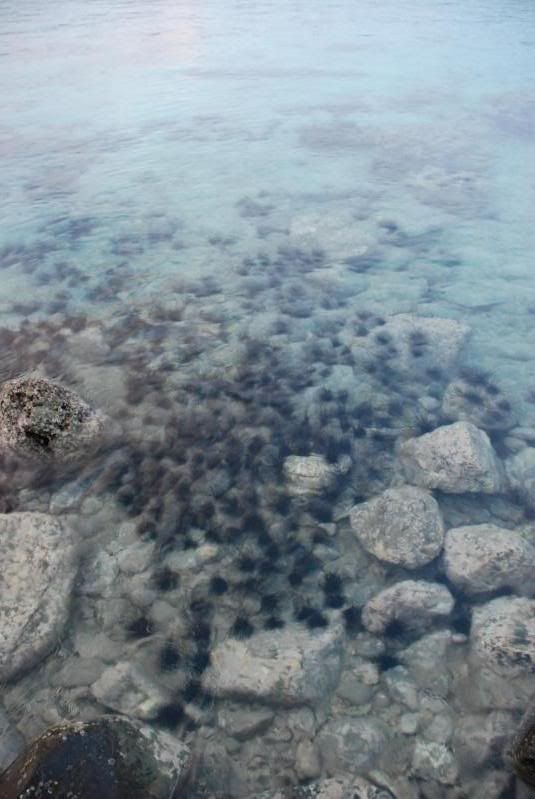
In Iboih the locals and tourists got on in a way that I have not seen before, probably due to the small numbers of both and repeat (and extended) visits paid by many Westerners - though this generally excluded the NGO crowd who arrived at weekends. My daily routine was simply - eat, dive, eat, dive, eat, sleep - with the odd snooze or beer at various points. In Iboih there is a well established trend of Western guys marrying local girls (with variable success) - I soon became the target of Eka, a lovely 29 year old who was already divorced from her Austrian husband and had 3 kids. I steered clear.
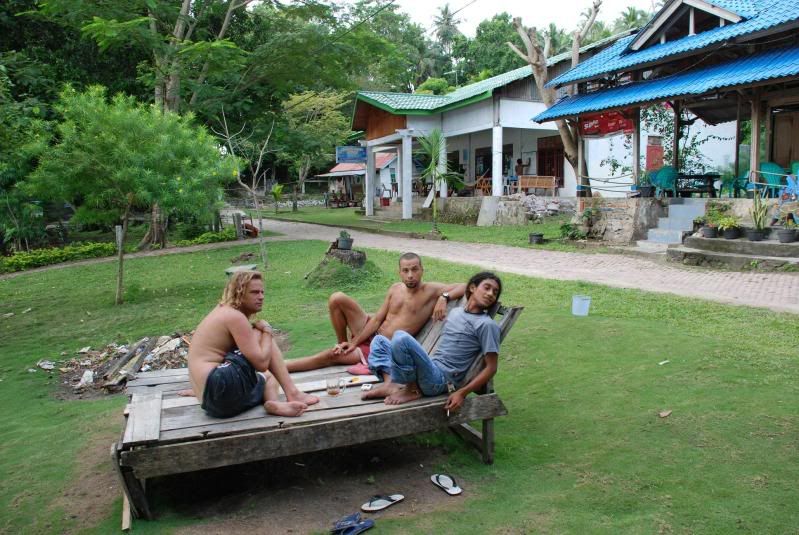
After a week I was running short of money, and headed back to Banda Aceh to see the sights before returning to the dreaded Medan. In truth, without knowing that a huge tsunami had struck just a few years ago, you would be hard pressed to tell. Most services work as good as, or better than, other places and buildings are either rebuilt or repaired. It didn't really hit me until we left that on the night bus; our becak driver took us via the "tsunami boat", a 100m long and 20m wide barge that had been lifted up and dumped across a road, several hundred metres inland - it was a sight that left me feeling overawed and a little shaken.
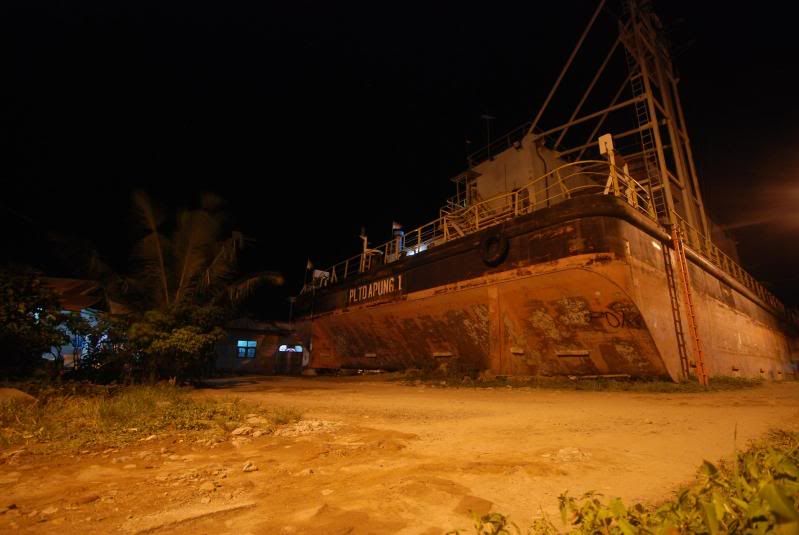
The tsunami boat
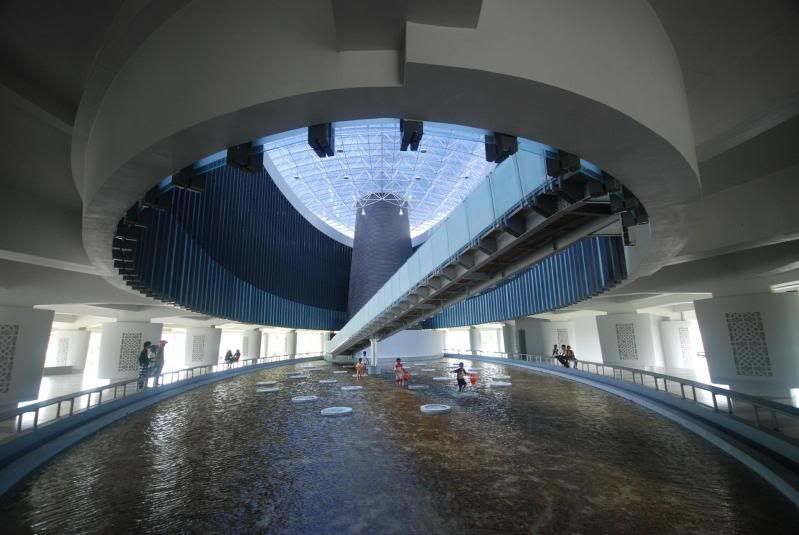
The (unfinished) tsunami museum
Back in Medan I met a group of tourists heading to Bukit Lawang, my next destination, and we chartered a minibus to take us. The road was predictably appalling although there was no smoking or karaoke onboard - I slept after a bumpy night from Banda. In Bukit Lawang I was already prepared with a place to stay, so I walked past the various guides and touts, ignoring the incorrect directions and offers of jungle treks, and headed to a guesthouse called Sams.
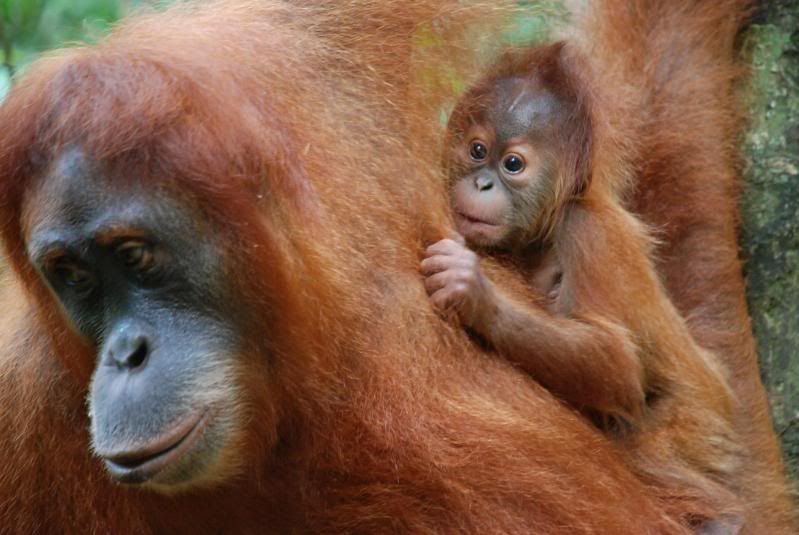
Bukit Lawang sits on the eastern border of Gunung Leuser National Park, and is home to Sumatra 5000-or-so remaining orangutans. Another previous highlight on the backpacker trail, the town had been all but swept away in 2003 by a flash flood that killed a large number of villagers. It was slowly recovering but still hosted fewer tourists that 15 years before - all the better for me. Bukit Lawang is also home to the visible side of Sumatra's orangutan (in Bahasa Indonesian, "forest man") rehabilitation programme. Here orangutans are reintroduced to the wild, taught how to climb and find food, and are eventually released. In practice the "semi-wild"apes are still fed twice daily with milk and bananas - only a few tend to come, but the majority of reintroduced apes live close to the Park headquarters at the edge of Bukit Lawang.
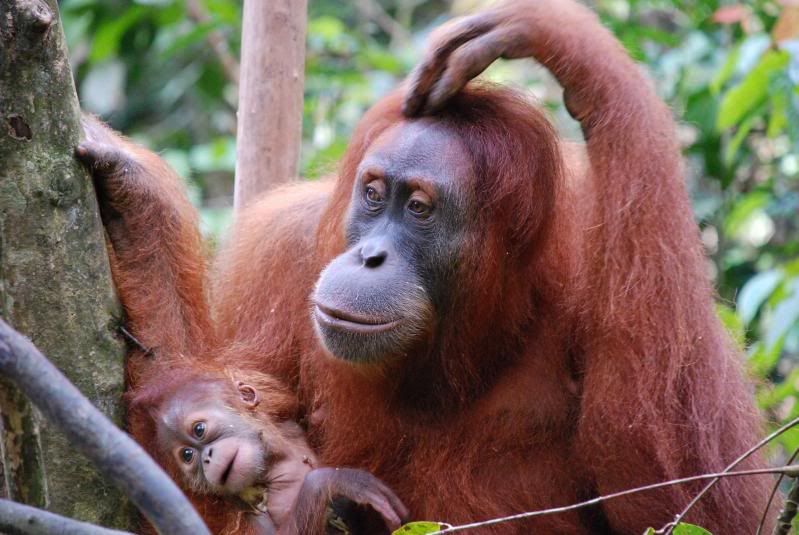
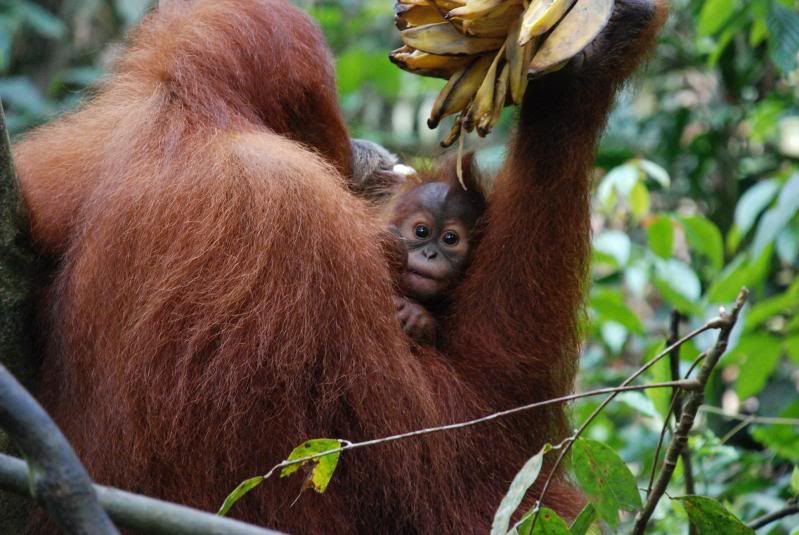
My guesthouse tip was a great one - situated right by the river, with superb food and beautiful rooms, and only a stones throw from Park HQ. Orangutans were visible in the trees on the opposite bank as well as long tailed macaques and the occasional monitor lizard. I met Debra and Pilar, 2 girls who had been staying at my guesthouse on Pulau Weh, and we agreed to do a 3 day jungle trek led by Sam, our guesthouse owner who had also been recommended.
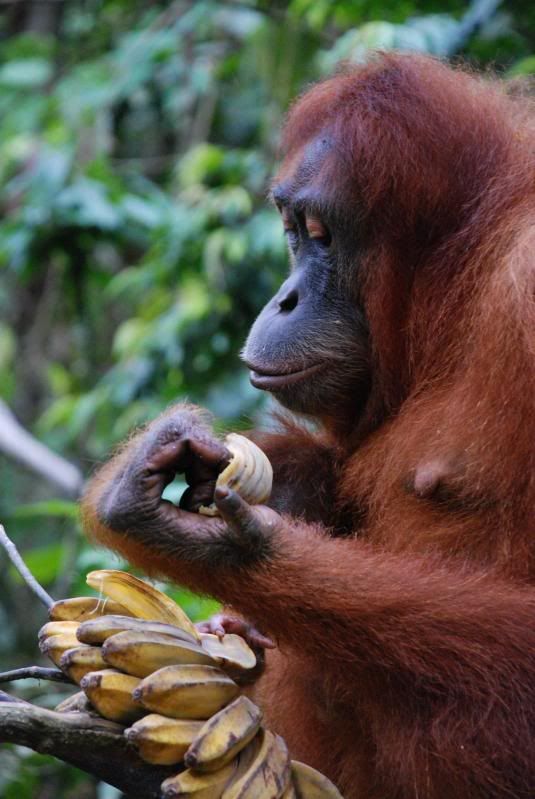
By this point we had all received unrelenting sales talk from a variety of guides who all offered their services for a jungle trek; the girls suffered worse than me as single girls tend to be targeted by amorous Indonesian men.It was amazing how quickly word spread that we had booked a trek - the hassle dropped to nothing within an hour.
The first afternoon I headed up to the feeding; it was incredible. There is little you can say about being so close to an orangutan - albeit a semi-wild one - they have grace, power and a look in their eyes both questioning and saddening.
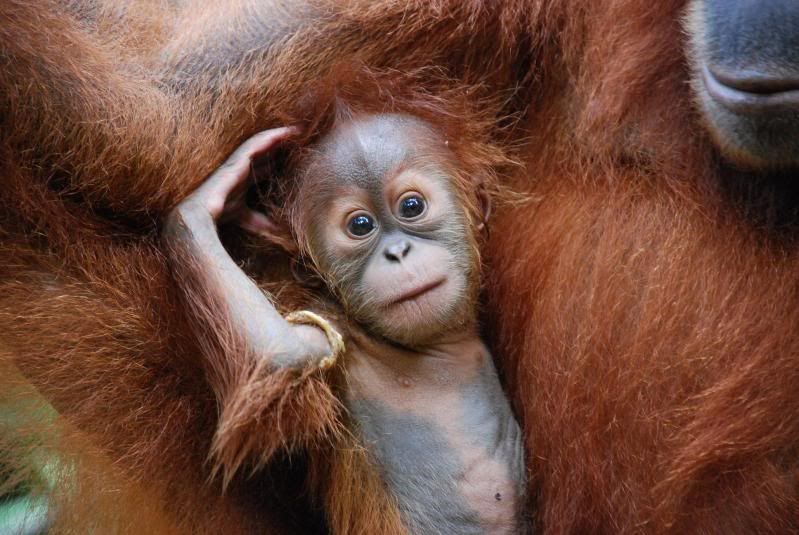
The next morning was the start of our jungle trek - Debs, Pilar and myself headed up to the morning feed, a different experience to the previous day as 30 Dutch tourists (and there 50 or so "helpers") were there in comparison to 4 opf us the day before. Even so, the orangutans showed up, including a huge wild male, who sat on a platform and observed proceedings with interest. He was fully aware of his power and possible threat to the people there, and happily accepted some bananas from the rangers in exchange for staying quiet.
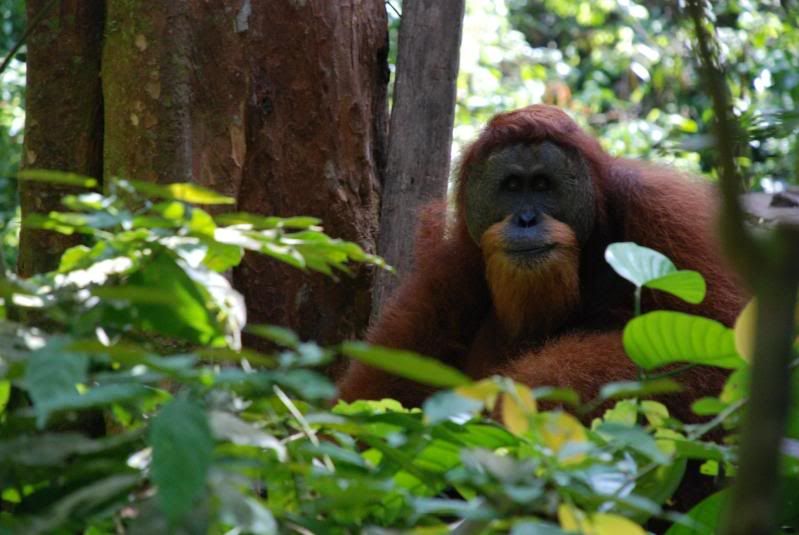
The wild male
After the rest departed, Sam, his helper Pete-Pete, Debs, Pilar and myself headed into the jungle. Sam took us on a short, very steep path to start - a test to see how well we coped with Gunung Leusers sheer-sided, jungle-clad hills. We passed with flying colours (Sam was especially surprised by how quick the girls were!) and he opted to extend his planned route for the day. We came across Mina, a semi-wild orangutan with baby who had honed the art of blocking the path of trekkers until fed some fruit. Fortunately we were too quick and were past her checkpoint before she arrived; she followed us somewhat grumpily for a few hundred metres before heading off to find another victim.
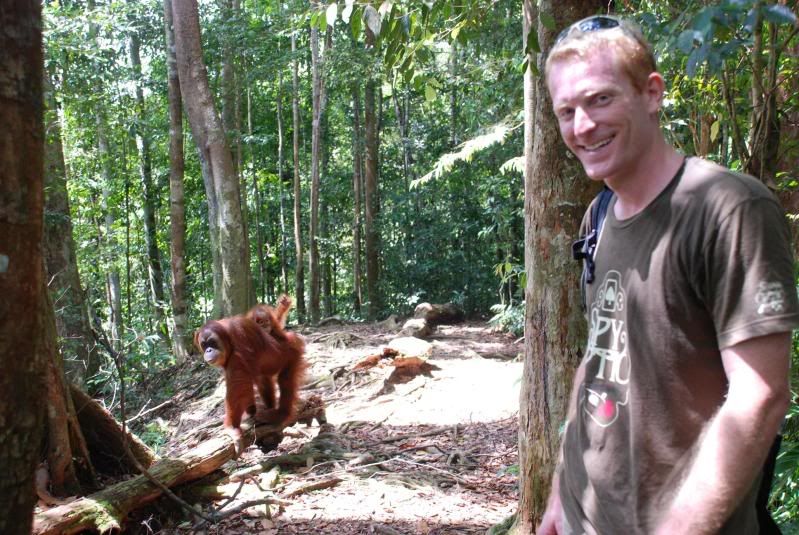
Gunung Leuser has 6 species of primates - long tailed and pig tailed macaques, Thomas Leaf monkeys, black siamangs, gibbons and orangutans. The semi-wild orangutans didn't really count in my book, but by the time we reached our camp by the river that evening we had seen both Thomas Leaf monkeys and a close-up view of a black siamang family group. As we swam in the river a rhinocerous hornbill flew down (huge, and looking rather stupid) and perched nearby, and a small wild orangutan made a nest up on the opposite river bank. It had been a tough day of walking - despite sticking to the ridges of the hills most of the time (these were usually quite dry but only a couple of yards wide) we had made a couple of ascents and descents into valley bottoms, where leeches abound and things get wet and slippery.
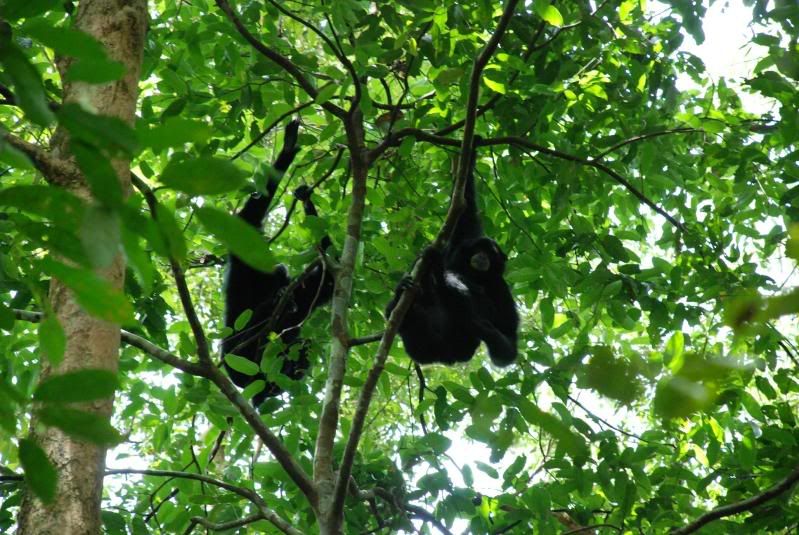
Black siamangs

Lunch, day 1
What we had expected was the huge quantity of delicious food prepared at camp by 2 more helpers. We went to bed tired, stuffed and looking forward to the next day. The camp was comfortable, our open-sided shelter by a river and there were thankfully few mosquitos; my only complaint was my little toe that I had stubbed and damaged the nail.
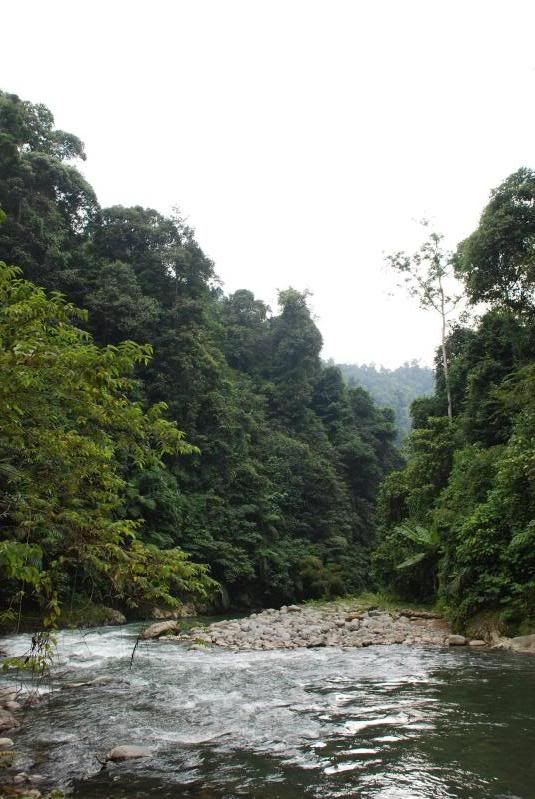
Camp, day 1
The next morning the orangutan opposite was feeding it the trees - we had our first good look but it was still at a distance. After a great breakfast we started on the trail again, and after a couple of hours spotted a wild orangutan and baby feeding in trees close to us. Sam was very pleased, especially when she stayed eating the fruit in the tree rather than moving away, as is usual. We watched her for half an hour before moving on to tackle steeper hills and be sucked on by leeches.
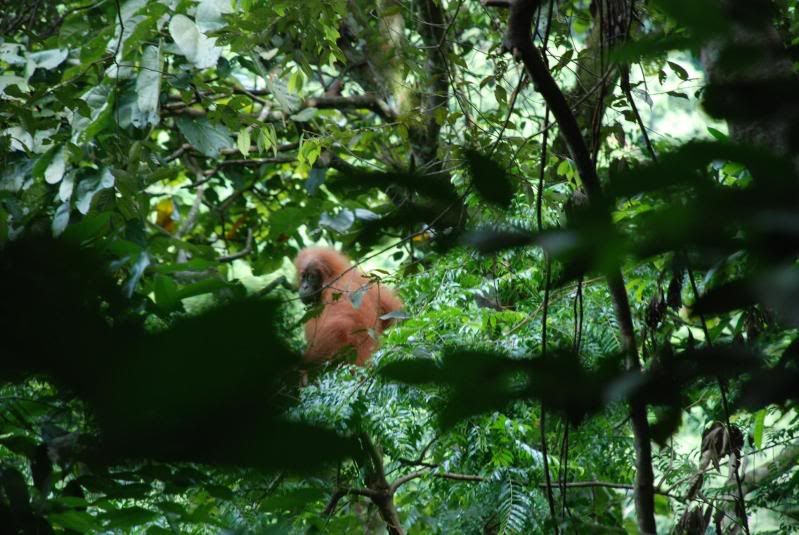
Wild juvenile orangutan
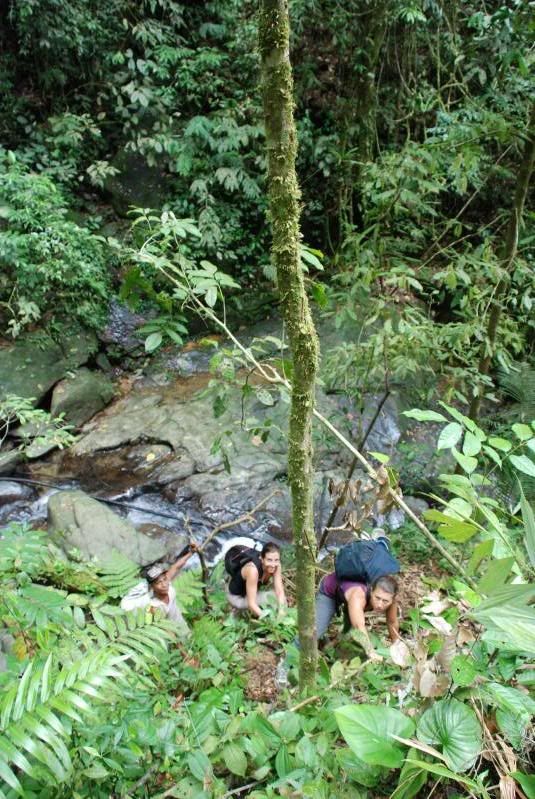
Steep climbs....
That evening it rained; we camped at a spot close to the river where there were clear signs of elephants - Gunung Leuser has both wild elephants and approximately 60 Sumatran tigers within it's 900,00 hectare area. With the rain came more leeches, and all of us found more as we sheltered under plastic playing cards.
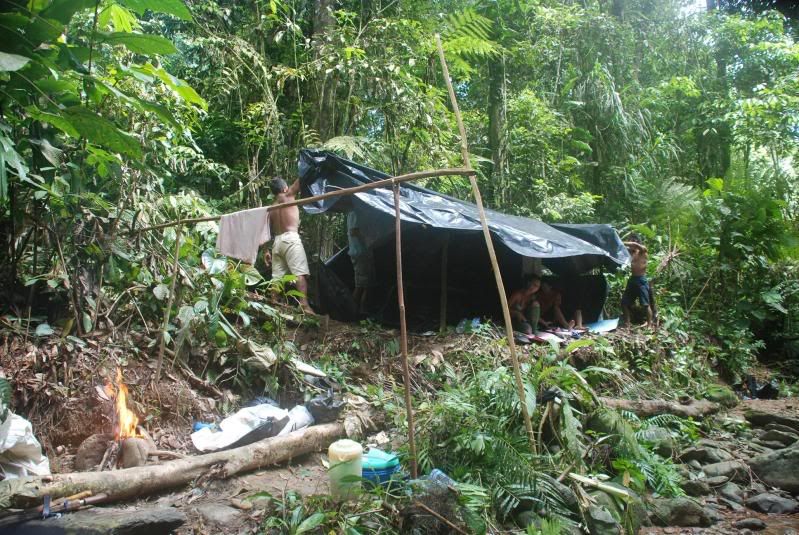
Striking camp on day 3
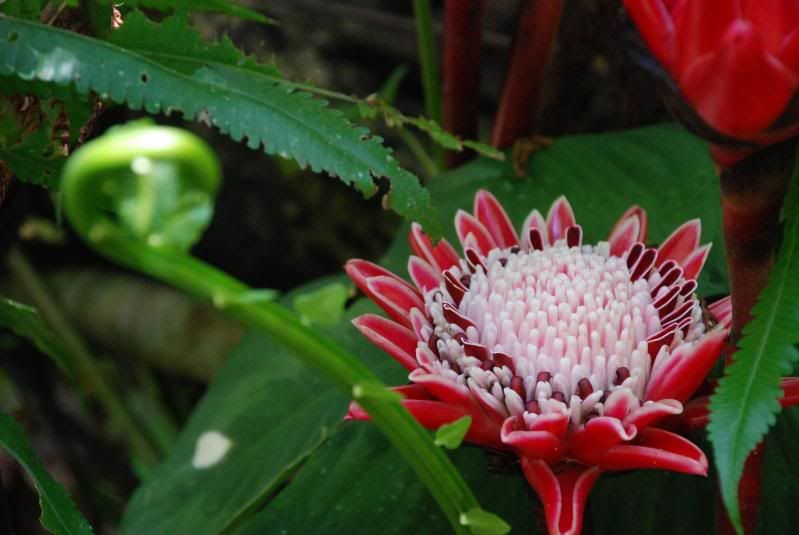
There are other things apart from monkeys in the jungle.....
The next day we had a short walk before the easiest part of the trek - floating back down to Bukit Lawang on a raft of inner tubes. Despite almost flipping the raft in one rapid, losing Debs, Pilar and some cargo in the process, we made it back in one piece and gratefully returned to the tranquil calm and dry of Sam's guesthouse for yet more delectable food and some well deserved showers.
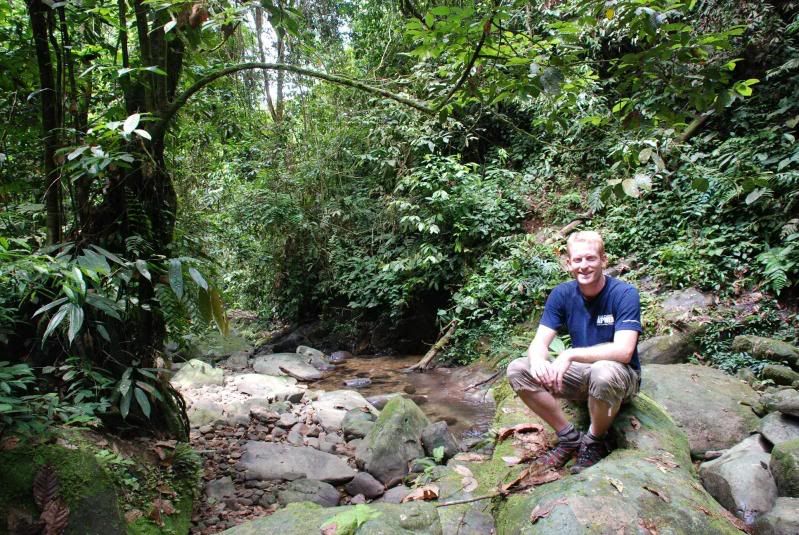
Debs and Pilar headed off the next morning; I stayed another day to see another feeding (Saza, one of the newer rehabilitation candidates, was brought back after turning up at a guesthouse close to the village) and did some much needed laundry. The following day I moved on myself- initially to Medan then up to Berastagi in the Karo Highlands of Northern Sumatra.

Culture shock doesn't come too easily to me, but I thought this might be a good place to explain a few of Indonesia's most obvious features to the uninitiated.
- "Hello Mister"
For those Indonesians with a little bit more English, you can now being a more in-depth conversation before working round to the reason they are talking to you. If it's a school-aged child, this reason is to ask you searching questions about your religion, government and opinion on Indonesia, before having a photo taken with all their friends on someone's camera phone. If the Indonesian is anywhere close to being an adult male, the reason is that, apart from being your new best friend, they can offer you some kind of service for just a nominal fee - usually expressed as "for you, I make very good price".
- Smoking
- Litter
- Driving
- Transport
- Eating/Sleeping/Washing
Once in Medan, I passed the queues of taxi drivers looking for becak to take me to a hotel - I had heard they were cheaper but, given that I hadn't really established what they looked like, ended up taking a taxi to a guesthouse. My taxi driver was a friendly fellow - within minutes I had his mobile number and he was suggesting I could do some business with him. He suggested a girl for a massage (with a "happy ending". no doubt") or the disco that evening; after I declined, he suggested maybe it was two girls I was after. We arrived at the guesthouse not a moment too soon, to find it levelled to the ground. I eventually made it to another hotel, despite my taxi-friend's objections that it was a "clean hotel" that didn't allow girls for massage.
I have yet to hear a positive word uttered about Medan. In the late '80's and early 90's, Sumatra was a major spot on the backpacking trail and tourist infrastructure existed. After the 1997 Asian financial crisis, the Bali bombs and the tsunami, Sumatra had almost been wiped off the map as a destination, replaced by Thailand, Laos, Cambodia and Vietnam. Medan is a prime example of why tourism is failing - or maybe it was like this because tourism was failing. There was a constant, mostly friendly hassle, but trying to acheive anything without being completely ripped off was a challenge. I stayed the night and the following morning headed up to Banda Aceh, at the northern tip of Sumatra.
Banda Aceh leapt to unwanted global fame after the Boxing Day tsunami in 2004. As the closest large city to the epicentre of the earthquake, many buildings were damaged before the tsunami hit. Arriving by air it was clear that there would have been little escape possible as the surrounding land is all flat. Notably the large mosque in Banda escaped almost unscathed, interpreted as a sign from God by the locals.

The province of Aceh, confusingly situated north of "Northern Sumatra", has also witnessed a separatist conflict lasting years, that ended only in 2006 with the signing of a deal to allow a large part of Aceh's export revenues to be kept within the province.

From the airport I hooked up with a couple of French travellers and headed directly to the brand-new port, past countless new concrete buildings and shiny blacked-put NGO vehicles. An express ferry for Pulau Weh, an island a few kilometres off the northern tip of Sumatra, soon after - my final destination was Iboih, a laid back village on a quiet bay with friendly locals and excellent diving.


The next week passed quickly; it was bliss not to have to worry about the usual transport rip-offs or hassles from locals. I stayed in a run-down chalet with a shared saltwater mandi - that grew tiring after a while, as did the electricity cuts for most of the daylight hours and the huge numbers of sea urchins among the rocks where I was staying.

In Iboih the locals and tourists got on in a way that I have not seen before, probably due to the small numbers of both and repeat (and extended) visits paid by many Westerners - though this generally excluded the NGO crowd who arrived at weekends. My daily routine was simply - eat, dive, eat, dive, eat, sleep - with the odd snooze or beer at various points. In Iboih there is a well established trend of Western guys marrying local girls (with variable success) - I soon became the target of Eka, a lovely 29 year old who was already divorced from her Austrian husband and had 3 kids. I steered clear.

After a week I was running short of money, and headed back to Banda Aceh to see the sights before returning to the dreaded Medan. In truth, without knowing that a huge tsunami had struck just a few years ago, you would be hard pressed to tell. Most services work as good as, or better than, other places and buildings are either rebuilt or repaired. It didn't really hit me until we left that on the night bus; our becak driver took us via the "tsunami boat", a 100m long and 20m wide barge that had been lifted up and dumped across a road, several hundred metres inland - it was a sight that left me feeling overawed and a little shaken.

The tsunami boat

The (unfinished) tsunami museum
Back in Medan I met a group of tourists heading to Bukit Lawang, my next destination, and we chartered a minibus to take us. The road was predictably appalling although there was no smoking or karaoke onboard - I slept after a bumpy night from Banda. In Bukit Lawang I was already prepared with a place to stay, so I walked past the various guides and touts, ignoring the incorrect directions and offers of jungle treks, and headed to a guesthouse called Sams.

Bukit Lawang sits on the eastern border of Gunung Leuser National Park, and is home to Sumatra 5000-or-so remaining orangutans. Another previous highlight on the backpacker trail, the town had been all but swept away in 2003 by a flash flood that killed a large number of villagers. It was slowly recovering but still hosted fewer tourists that 15 years before - all the better for me. Bukit Lawang is also home to the visible side of Sumatra's orangutan (in Bahasa Indonesian, "forest man") rehabilitation programme. Here orangutans are reintroduced to the wild, taught how to climb and find food, and are eventually released. In practice the "semi-wild"apes are still fed twice daily with milk and bananas - only a few tend to come, but the majority of reintroduced apes live close to the Park headquarters at the edge of Bukit Lawang.


My guesthouse tip was a great one - situated right by the river, with superb food and beautiful rooms, and only a stones throw from Park HQ. Orangutans were visible in the trees on the opposite bank as well as long tailed macaques and the occasional monitor lizard. I met Debra and Pilar, 2 girls who had been staying at my guesthouse on Pulau Weh, and we agreed to do a 3 day jungle trek led by Sam, our guesthouse owner who had also been recommended.

By this point we had all received unrelenting sales talk from a variety of guides who all offered their services for a jungle trek; the girls suffered worse than me as single girls tend to be targeted by amorous Indonesian men.It was amazing how quickly word spread that we had booked a trek - the hassle dropped to nothing within an hour.
The first afternoon I headed up to the feeding; it was incredible. There is little you can say about being so close to an orangutan - albeit a semi-wild one - they have grace, power and a look in their eyes both questioning and saddening.

The next morning was the start of our jungle trek - Debs, Pilar and myself headed up to the morning feed, a different experience to the previous day as 30 Dutch tourists (and there 50 or so "helpers") were there in comparison to 4 opf us the day before. Even so, the orangutans showed up, including a huge wild male, who sat on a platform and observed proceedings with interest. He was fully aware of his power and possible threat to the people there, and happily accepted some bananas from the rangers in exchange for staying quiet.

The wild male
After the rest departed, Sam, his helper Pete-Pete, Debs, Pilar and myself headed into the jungle. Sam took us on a short, very steep path to start - a test to see how well we coped with Gunung Leusers sheer-sided, jungle-clad hills. We passed with flying colours (Sam was especially surprised by how quick the girls were!) and he opted to extend his planned route for the day. We came across Mina, a semi-wild orangutan with baby who had honed the art of blocking the path of trekkers until fed some fruit. Fortunately we were too quick and were past her checkpoint before she arrived; she followed us somewhat grumpily for a few hundred metres before heading off to find another victim.

Gunung Leuser has 6 species of primates - long tailed and pig tailed macaques, Thomas Leaf monkeys, black siamangs, gibbons and orangutans. The semi-wild orangutans didn't really count in my book, but by the time we reached our camp by the river that evening we had seen both Thomas Leaf monkeys and a close-up view of a black siamang family group. As we swam in the river a rhinocerous hornbill flew down (huge, and looking rather stupid) and perched nearby, and a small wild orangutan made a nest up on the opposite river bank. It had been a tough day of walking - despite sticking to the ridges of the hills most of the time (these were usually quite dry but only a couple of yards wide) we had made a couple of ascents and descents into valley bottoms, where leeches abound and things get wet and slippery.

Black siamangs

Lunch, day 1
What we had expected was the huge quantity of delicious food prepared at camp by 2 more helpers. We went to bed tired, stuffed and looking forward to the next day. The camp was comfortable, our open-sided shelter by a river and there were thankfully few mosquitos; my only complaint was my little toe that I had stubbed and damaged the nail.

Camp, day 1
The next morning the orangutan opposite was feeding it the trees - we had our first good look but it was still at a distance. After a great breakfast we started on the trail again, and after a couple of hours spotted a wild orangutan and baby feeding in trees close to us. Sam was very pleased, especially when she stayed eating the fruit in the tree rather than moving away, as is usual. We watched her for half an hour before moving on to tackle steeper hills and be sucked on by leeches.

Wild juvenile orangutan

Steep climbs....
That evening it rained; we camped at a spot close to the river where there were clear signs of elephants - Gunung Leuser has both wild elephants and approximately 60 Sumatran tigers within it's 900,00 hectare area. With the rain came more leeches, and all of us found more as we sheltered under plastic playing cards.

Striking camp on day 3

There are other things apart from monkeys in the jungle.....
The next day we had a short walk before the easiest part of the trek - floating back down to Bukit Lawang on a raft of inner tubes. Despite almost flipping the raft in one rapid, losing Debs, Pilar and some cargo in the process, we made it back in one piece and gratefully returned to the tranquil calm and dry of Sam's guesthouse for yet more delectable food and some well deserved showers.

Debs and Pilar headed off the next morning; I stayed another day to see another feeding (Saza, one of the newer rehabilitation candidates, was brought back after turning up at a guesthouse close to the village) and did some much needed laundry. The following day I moved on myself- initially to Medan then up to Berastagi in the Karo Highlands of Northern Sumatra.

